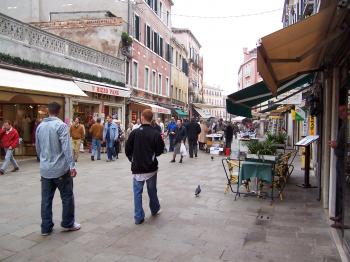Getting Around Venice
Getting Around Venice
All City Transport Options: What Locals Use and What’s Best for Tourists
General Overview
Getting around Venice can be an adventure in itself. One thing that surprised me about Venice transport is the lack of cars. Instead of streets, you've got canals and narrow alleys, which makes getting from one place to another feel like a mini-exploration every time. The public transport system here is surprisingly efficient, especially if you’re used to more conventional setups.There are a few main transport options: the Vaporetto (water bus), traghetti (gondola ferry), and water taxis. The Vaporetto is your best friend for longer distances across the Grand Canal and out into the lagoon. You’ll want to check out Line 1 for a scenic ride past all the major sights like Piazza San Marco and the Rialto Bridge. Expect to pay around €7.50 for a single ticket (kind of pricey compared to other cities), but you can get a 1-day pass for around €22. Just remember, peak times usually mean more crowds and longer wait times.
Oh, before I forget, a common mistake tourists make is thinking they can buy tickets directly on the Vaporetto. You actually need to grab them at the station or through a transport app. I learned this the hard way and ended up having to scramble to get a ticket before boarding!
On my first ride, I was a bit frustrated; it was rush hour, and I found myself packed like a sardine, freezing from the wind. But on another occasion, I unexpectedly caught the Vaporetto just at sunset, and the view was magical—definitely a highlight!
As for saving money, instead of splurging on water taxis, try using the traghetti for quick crossings; they’re much cheaper and just as fun. If you're traveling in groups, the group ticket options can save you some cash too.
Weather can throw a wrench in your plans, especially in winter when fog can make navigating the canals tricky. Just be prepared for potential delays if the visibility drops.
Final tip? If you're travelling during the busy seasons, aim for morning rides before the crowds swarm in. Enjoy the ride, and embrace the unique quirks of moving around Venice!
Types of Transport

popular with tourists
Walking in Venice is not only the most scenic way to navigate the city, but it also offers the chance to discover hidden gems away from the crowded tourist paths. There are no costs or payment methods involved since walking is free, making it accessible for everyone. A great route to explore is from St. Mark's Basilica to the Rialto Bridge, which will take you through picturesque squares (campi) and winding alleyways, revealing local shops and cafes along the way.
Be sure to wear comfortable shoes, as the cobblestones can be uneven, and street signs can be scarce; keep a map or a navigation app handy to help with directions. For a unique experience, consider strolling in the quiet early morning hours when the city is less crowded, allowing you to enjoy the tranquility and beauty of Venice before the hustle and bustle begins. Lastly, always be mindful of your surroundings and stay aware of your belongings, especially in crowded areas where pickpockets may operate.
Be sure to wear comfortable shoes, as the cobblestones can be uneven, and street signs can be scarce; keep a map or a navigation app handy to help with directions. For a unique experience, consider strolling in the quiet early morning hours when the city is less crowded, allowing you to enjoy the tranquility and beauty of Venice before the hustle and bustle begins. Lastly, always be mindful of your surroundings and stay aware of your belongings, especially in crowded areas where pickpockets may operate.

popular with tourists
The boat system in Venice is primarily composed of Vaporetto (water buses), which operate like public transport across the Grand Canal and surrounding islands, providing a unique way to explore the city. A single ticket costs around €7.50, but consider a multi-day pass (available for 1, 2, or 3 days) that can help save money if you plan to use the boats frequently; these passes can be purchased at ticket kiosks or online. Key routes for tourists include the Vaporetto Line 1 along the Grand Canal, which passes popular landmarks like the Rialto Bridge and St. Mark’s Square. It’s advisable to avoid peak hours to secure a good view and enjoy a less crowded experience. Lastly, remember to hold onto your ticket until you disembark, as ticket inspectors conduct checks regularly, and fines apply if you’re caught without one.
The ferry service in Venice, operated by Actv, covers key routes across the Grand Canal and to various islands such as Murano, Burano, and Lido, making it an essential transport mode for tourists. A single ticket costs around €7.50 and is valid for 75 minutes, allowing transfers between routes; you can purchase tickets at ticket booths, automated machines, or via the Actv mobile app for convenience. For a more economical option, consider the 24-hour pass for €20, which allows unlimited travel on ferries during that period. When using the ferry, always be mindful of the timetables, as services can reduce in the evening, and try to travel during off-peak hours to avoid the crowds. For safety, try not to rush while boarding or disembarking, as the boats can move quickly and the steps can be steep.
Here you can learn about all types of transport in Venice. What transport is available, how to reach tourist attractions and which mode of transport is optimal.

